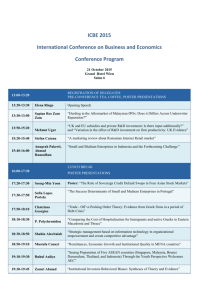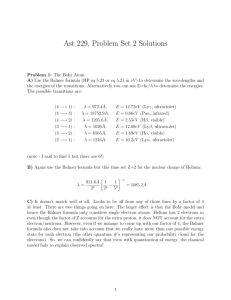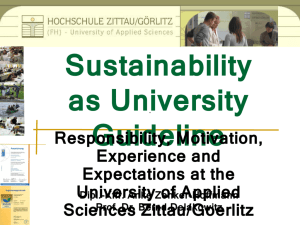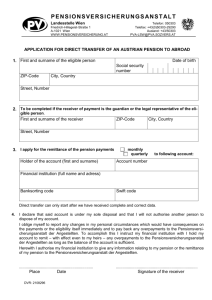Class Diagram - UML@Classroom
advertisement
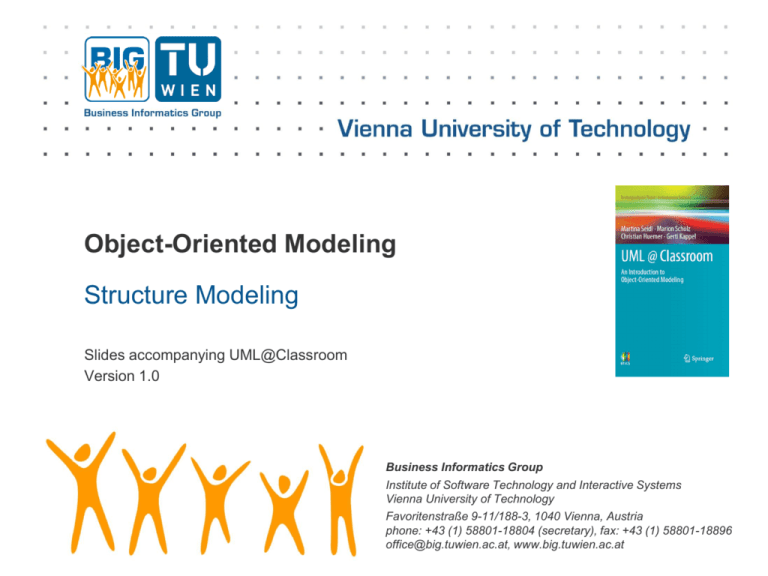
Object-Oriented Modeling
Structure Modeling
Slides accompanying UML@Classroom
Version 1.0
Business Informatics Group
Institute of Software Technology and Interactive Systems
Vienna University of Technology
Favoritenstraße 9-11/188-3, 1040 Vienna, Austria
phone: +43 (1) 58801-18804 (secretary), fax: +43 (1) 58801-18896
office@big.tuwien.ac.at, www.big.tuwien.ac.at
Literature
The lecture is based on the following book:
UML @ Classroom:
An Introduction to Object-Oriented
Modeling
Martina Seidl, Marion Scholz, Christian
Huemer and Gerti Kappel
Springer Publishing, 2015
ISBN 3319127411
© BIG / TU Wien
Use Case Diagram
Structure Modeling
State Machine Diagram
Sequence Diagram
Activity Diagram
2
Content
Objects
Classes
Attributes
Operations
Relationships
Binary Association
N-ary Association
Association Class
Aggregation
Generalization
Creating a class diagram
Code Generation
© BIG / TU Wien
3
Object
Individuals of a system
Alternative notations:
Attribute
Current value
© BIG / TU Wien
Object name
Class
Anonymous objects
= no object name
4
Object Diagram
Objects of a system and their relationships (links)
Snapshot of objects at a specific moment in time
Link
© BIG / TU Wien
5
From Object to Class
Individuals of a system often have identical characteristics and behavior
A class is a construction plan for a set of similar objects of a system
Objects are instances of classes
Class
Attributes: structural characteristics of a class
Different value for each instance (= object)
Operations: behavior of a class
Identical for all objects of a class
not depicted in object diagram
© BIG / TU Wien
Object of that class
6
Class
Class name
Attributes
Operations
© BIG / TU Wien
7
Attribute Syntax
© BIG / TU Wien
8
Attribute Syntax - Visibility
Who is permitted to access the attribute
© BIG / TU Wien
+ ... public: everybody
- ... private: only the object itself
# ... protected: class itself and subclasses
~ ... package: classes that are in the same package
9
Attribute Syntax - Derived Attribute
Attribute value is derived from other attributes
age: calculated from the date of birth
© BIG / TU Wien
10
Attribute Syntax - Name
Name of the attribute
© BIG / TU Wien
11
Attribute Syntax - Type
Type
User-defined classes
Data type
Primitive data type
Pre-defined: Boolean, Integer, UnlimitedNatural, String
User-defined: «primitive»
Composite data type: «datatype»
Enumerations: «enumeration»
© BIG / TU Wien
12
Attribute Syntax - Multiplicity
Number of values an attribute may contain
Default value: 1
Notation: [min..max]
no upper limit: [*] or [0..*]
© BIG / TU Wien
13
Attribute Syntax – Default Value
Default value
Used if the attribute value is not set explicitly by the
user
© BIG / TU Wien
14
Attribute Syntax – Properties
Pre-defined properties
{readOnly} … value cannot be changed
{unique} … no duplicates permitted
{non-unique} … duplicates permitted
{ordered} … fixed order of the values
{unordered} … no fixed order of the values
Attribute specification
Set: {unordered, unique}
Multi-set: {unordered, non-unique}
Ordered set: {ordered, unique}
List: {ordered, non-unique}
15
Operation Syntax - Parameters
Notation similar to attributes
Direction of the parameter
in … input parameter
When the operation is used, a value is
expected from this parameter
out … output parameter
After the execution of the operation, the
parameter has adopted a new value
inout : combined input/output parameter
16
Operation Syntax - Type
Type of the return value
© BIG / TU Wien
17
Class Variable and Class Operation
Instance variable (= instance attribute): attributes defined on instance level
Class variable (= class attribute, static attribute)
Defined only once per class, i.e., shared by all instances of the class
E.g. counters for the number of instances of a class, constants, etc.
Class operation (= static operation)
Can be used if no instance of the corresponding class was created
E.g. constructors, counting operations, math. functions (sin(x)), etc.
Notation: underlining name of class variable / class operation
class Person {
public String firstName;
public String lastName;
private Date dob;
protected String[] address;
private static int pNumber;
public static int getPNumber() {…}
public Date getDob() {…}
Class
variable
Class
operation
}
18
Specification of Classes: Different Levels of Detail
coarse-grained
© BIG / TU Wien
fine-grained
19
Association
Models possible relationships between instances of classes
© BIG / TU Wien
20
Binary Association
Connects instances of two classes with one another
Navigability
Association name
Reading direction
Multiplicity
Non-navigability
Visibility
© BIG / TU Wien
Role
21
Binary Association - Navigability
Navigability: an object knows its partner objects and can therefore
access their visible attributes and operations
Indicated by open arrow head
Non-navigability
Indicated by cross
Example:
A can access the visible attributes and
operations of B
B cannot access any attributes and
operations of A
Navigability undefined
Bidirectional navigability is assumed
© BIG / TU Wien
22
Navigability – UML Standard vs. Best Practice
UML standard
© BIG / TU Wien
Best practice
23
Binary Association as Attribute
Preferable
Java-like notation:
class Professor {…}
class Student{
public Professor[] lecturer;
…
}
24
Binary Association – Multiplicity and Role
Multiplicity: Number of objects that may be associated with exactly one
object of the opposite side
Role: describes the way in which an object is involved in an association
relationship
© BIG / TU Wien
25
Binary Association – xor constraint
“exclusive or” constraint
An object of class A is to be associated with an object of class B or an
object of class C but not with both.
© BIG / TU Wien
26
Unary Association - Example
© BIG / TU Wien
27
n-ary Association (1/2)
More than two partner objects are involved in the relationship.
No navigation directions
Ternary
association
© BIG / TU Wien
28
n-ary Association (2/2)
Example
(Student, Exam) (Lecturer)
One student takes one exam with one or no lecturer
(Exam, Lecturer) (Student)
One exam with one lecturer can be taken by any number of students
(Student, Lecturer) (Exam)
One student can be graded by one Lecturer for any number of exams
≠
© BIG / TU Wien
29
Association Class
Assign attributes to the relationship between classes rather than to a
class itself
© BIG / TU Wien
30
Association Class
Necessary when modeling n:m Associations
Association class
With 1:1 or 1:n possible but not necessary
© BIG / TU Wien
31
Association Class vs. Regular Class
≠
A Student can enroll for one
particular StudyProgram only
once
© BIG / TU Wien
A Student can have mutiple
Enrollments for one and the
same StudyProgram
32
Association Class – unique/non-unique (1/2)
Default: no duplicates
non-unique: duplicates allowed
A student can only be granted an
exam meeting for a specific exam once.
A student can have more than one
exam meetings for a specific exam.
© BIG / TU Wien
33
Association Class – unique/non-unique (2/2)
© BIG / TU Wien
34
Aggregation
Special form of association
Used to express that a class is part of another class
Properties of the aggregation association:
Transitive: if B is part of A and C is part of B, C is also part of A
Asymmetric: it is not possible for A to be part of B and B to be part of A
simultaneously.
Two types:
Shared aggregation
Composition
© BIG / TU Wien
35
Shared Aggregation
Expresses a weak belonging of the parts to a whole
= Parts also exist independently of the whole
Multiplicity at the aggregating end may be >1
= One element can be part of multiple other elements simultaneously
Spans a directed acyclic graph
Syntax: Hollow diamond at the aggregating end
Example:
Student is part of LabClass
Course is part of StudyProgram
© BIG / TU Wien
36
Composition
Existence dependency between the composite object and its parts
One part can only be contained in at most one composite object at one
specific point in time
Multiplicity at the aggregating end max. 1
-> The composite objects form a tree
If the composite object is deleted, its parts are also deleted.
Syntax: Solid diamond at the aggregating end
Example: Beamer is part of LectureHall is part of Building
If the Building is deleted,
the LectureHall is also deleted
© BIG / TU Wien
The Beamer can exist without the
LectureHall, but if it is contained in the
LectureHall while it is deleted, the Beamer
is also deleted
37
Shared Aggregation and Composition
Which model applies?
© BIG / TU Wien
38
Shared Aggregation and Composition
Which model applys?
A Tire cannot exist without a Car.
----Yes--- ---------No-------- ----Yes---
A Tire can exist without a Car. A
Tire belongs to one Car at most.
A Tire can belong to multiple Cars
A Car has one or two types of
Tires. Several Cars may have
the same Type of Tires.
© BIG / TU Wien
39
Generalization
Characteristics (attributes and operations),
associations, and aggregations that are
specified for a general class (superclass)
are passed on to its subclasses.
Every instance of a subclass is
simultaneously an indirect instance of the
superclass.
Subclass inherits all characteristics,
associations, and aggregations of the
superclass except private ones.
Subclass may have further characteristics,
associations, and aggregations.
Generalizations are transitive.
© BIG / TU Wien
Superclass
Subclasses
…inherit characteristics,
associations, and
aggregations
A Secretary is
an Employee and
a Person
40
Generalization – Abstract Class
Used to highlight common characteristics of their subclasses.
Used to ensure that there are no direct instances of the superclass.
Only its non-abstract subclasses can be instantiated.
Useful in the context of generalization relationships.
Notation: keyword {abstract} or class name in italic font.
No Person-object possible
Two types of Person: Man and Woman
© BIG / TU Wien
41
Generalization – Multiple Inheritance
UML allows multiple inheritance.
A class may have multiple superclasses.
Example:
A Tutor is both an Employee and a Student
© BIG / TU Wien
42
With and Without Generalization
© BIG / TU Wien
43
Creating a Class Diagram
Not possible to completely extract classes, attributes and associations
from a natural language text automatically.
Guidelines
Nouns often indicate classes
Adjectives indicate attribute values
Verbs indicate operations
Example: The library management system stores users with their
unique ID, name and address as well as books with their title, author
and ISBN number. Ann Foster wants to use the library.
© BIG / TU Wien
Question: What about Ann Foster?
44
Example – University Information System
A university consists of multiple faculties which are composed of various institutes.
Each faculty and each institute has a name. An address is known for each institute.
Each faculty is led by a dean, who is an employee of the university.
The total number of employees is known. Employees have a social security number,
a name, and an email address. There is a distinction between research and
administrative personnel.
Research associates are assigned to at least one institute. The field of study of
each research associate is known. Furthermore, research associates can be
involved in projects for a certain number of hours, and the name, starting date, and
end date of the projects are known. Some research associates hold courses. Then
they are called lecturers.
Courses have a unique number (ID), a name, and a weekly duration in hours.
© BIG / TU Wien
45
Example – Step 1: Identifying Classes
We model the system „University“
A university consists of multiple faculties
which are composed of various institutes.
Each faculty and each institute has a name.
An address is known for each institute.
Each faculty is led by a dean, who is an
employee of the university.
The total number of employees is known.
Employees have a social security number,
a name, and an email address. There is a
distinction between research and
administrative personnel.
Research associates are assigned to at
least one institute. The field of study of
each research associate is known.
Furthermore, research associates can be
involved in projects for a certain number of
hours, and the name, starting date, and
end date of the projects are known. Some
research associates hold courses. Then
Dean has no further attributes than
they are called lecturers.
any other employee
Courses have a unique number (ID), a
name, and a weekly duration in hours.
46
Example – Step 2: Identifying the Attributes
A university consists of multiple faculties
which are composed of various institutes.
Each faculty and each institute has a name.
An address is known for each institute.
Each faculty is led by a dean, who is an
employee of the university.
The total number of employees is known.
Employees have a social security number,
a name, and an email address. There is a
distinction between research and
administrative personnel.
Research associates are assigned to at
least one institute. The field of study of
each research associate is known.
Furthermore, research associates can be
involved in projects for a certain number of
hours, and the name, starting date, and
end date of the projects are known. Some
research associates hold courses. Then
they are called lecturers.
Courses have a unique number (ID), a
name, and a weekly duration in hours.
47
Example – Step 2: Identifying Relationships (1/6)
Three kinds of relationships:
Association
Generalization
Aggregation
Abstract, i.e., no other types
of employees
Indication of a generalization
“There is a distinction between research
and administrative personnel.”
“Some research associates hold courses.
Then they are called lecturers.”
© BIG / TU Wien
48
Example – Step 2: Identifying Relationships (2/6)
“A university consists of multiple faculties which are composed of
various institutes.”
Composition to show existence
dependency
© BIG / TU Wien
49
Example – Step 2: Identifying Relationships (3/6)
“Each faculty is led by a dean, who is an employee of the university”
In the leads-relationship, the
Employee takes the role of a dean.
© BIG / TU Wien
50
Example – Step 2: Identifying Relationships (4/6)
“Research associates are assigned to at least one institute.”
Shared aggregation to show that ResearchAssociates
are part of an Institute,
but there is no existence dependency
© BIG / TU Wien
51
Example – Step 2: Identifying Relationships (5/6)
“Furthermore, research associates can be involved in projects for a
certain number of hours.”
Association class enables to store
the number of hours for every
single Project of every single
ResearchAssociate
© BIG / TU Wien
52
Example – Step 2: Identifying Relationships (6/6)
“Some research associates hold courses. Then they are called
lecturers.”
Lecturer inherits all characteristics,
associations, and aggregations from
ResearchAssociate.
In addtion, a Lecturer has an association
teaches to Course.
© BIG / TU Wien
53
Example – Complete Class Diagram
54
Code Generation
Class diagrams are often created with the intention of
implementing the modeled elements in an object-oriented
programming language.
Often, translation is semi-automatic and requires only minimal
manual intervention.
© BIG / TU Wien
55
Code Generation – Example (1/6)
class Course {
public int courseNo;
}
© BIG / TU Wien
56
Code Generation – Example (2/6)
abstract class UniversityMember {
public String firstName;
public String lastName;
public int ssNo;
}
© BIG / TU Wien
57
Code Generation – Example (3/6)
Enumeration ESemester {
winter,
summer
}
Enumeration ERole {
lecturer,
tutor,
examiner
}
© BIG / TU Wien
58
Code Generation – Example (4/6)
class Student extends
UniversityMember
UniversityMember
{
{
public int matNo;
public CourseExecution []
completedCourses;
completedCourses;
}
© BIG / TU Wien
59
Code Generation – Example (5/6)
class
class Employee
Employee extends
extends UniversityMember
UniversityMember {{
private
private int
int acctNo;
acctNo;
public
public int
int getAcctNo
getAcctNo ()
{ {
return
return acctNo;
acctNo;
}}
public
public CourseExecution
CourseExecution []
[] courseExecutions;
courseExecution;
}}
© BIG / TU Wien
60
Code Generation – Example (6/6)
class CourseExecution {
public int year;
public ESemester semester;
public Student [] student;
public Course course;
public Hashtable support;
// Key: employee
// Value: (role, hours)
}
© BIG / TU Wien
61
Notation Elements (1/3)
Name
Notation
Description
Description of the structure and
behavior of a set of objects
Class
oder
Abstract class
Class that cannot be instantiated
Association
Relationship between classes:
navigability unspecified,
navigable in both directions,
not navigable in one direction
© BIG / TU Wien
62
Notation Elements (2/3)
Name
Notation
Description
n-ary
association
Relationship between n (here 3)
classes
Association class
More detailed description of an
association
xor relationship
An object of C is in a relationship
with an object of A or with an
object of B but not with both
© BIG / TU Wien
63
Notation Elements (3/3)
Name
Notation
Description
Shared
aggregation
Parts-whole relationship (A is part
of B)
Strong
aggregation =
composition
Existence-dependent parts-whole
relationship (A is part of B)
Generalization
Inheritance relationship (A
inherits from B)
Object
Instance of a class
Link
Relationship between objects
© BIG / TU Wien
64

